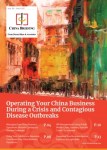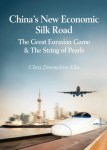Impact Of Covid-19 On China’s Global Belt & Road Project Financing – Q&A
Over the past three years, Silk Road Briefing has become one of the go-too platforms for up to the minute news, commentary and opinion concerning China’s Belt & Road Initiative, with its main contributor, Chris Devonshire-Ellis being able to concentrate on the scheme as part of his New Business Development role as Chairman of Dezan Shira & Associates, and due to his ability to travel throughout the region.
Chris has a 30 year career based in China, and more recently Russia, and is uniquely placed to provide meaningful insights. “As Dezan Shira & Associates has grown, I have been able to free myself up from purely China duties and get engaged in new territories and regions impacted by China’s development” he states. “We have a very competent board of directors, management team and actively involved shareholders, and this is a great help when looking into global opportunity trends and developments. China’s Belt & Road Initiative is almost certainly the largest of them all.”
Rather than sitting in an office at a desk, Chris is also able to walk the walk and travel the region. “I am a bit of a nomad, and sometimes lecture in St.Petersburg at the Higher School of Economics as well as other academic institutions. I have many friends across the Belt & Road region who I often visit, and lucky enough to maintain several homes across Eurasia. I am on a perpetual cycle of regional travel rather than being stuck in one office, and this allows me to obtain differing perspectives and see angles that sedentary, one office based executives cannot”.
Consequently Chris is often asked to comment on matters concerning the Belt & Road. Here are some recent answers to questions posed by various media, including writers from Forbes and Oxford Business Group that were not featured in their original copy:
Q: What do you expect will be the short-term implications for big-ticket BRI infrastructure projects that were underway or in the immediate pipeline?
A: Many of these projects are in countries where the development of Covid-19 remains uncertain and has yet to be played out. Some are in poorer nations who may require medical and healthcare assistance as a priority ahead of continuing infrastructure projects, and this will vary from country to country. There is also the issue of overseas Chinese labour, and how this can be managed. That is now a partially political issue, although most overseas labourers live in specific work camps next to the construction site and do not mingle with the general population. Both these factors require a considered approach and this will lead to delays in project resumption. However in time this will be resolved.
Q: Considering how the Covid-19 pandemic has increased the fiscal and domestic pressures facing China, to what extent do you expect BRI projects in the pipeline will be made more open to co-financing and private capital?
A: The typical preference for China and recipient countries is that such projects are conducted on a G2G basis, and preferably using either solely Chinese sub-contractors, or JV’s with the recipient nation owned SOEs. There are numerous reasons for this, including confidential G2G government financing terms, China’s preference for leveraging projects to gain overseas political influence, and their easier working relations with Government (SOE), rather than privately owned contractors. I do not expect this attitude or modus operandi to change very much unless considered absolutely necessary.
Wade Shepard, Forbes & The New Silk Road
Q: Given what we’ve seen so far at this stage of the Covid-19 pandemic, how do you think the BRI willl fare in the coming years? What changes do you think we’ll see? What impact could it have to help in the recovery process?
A: The BRI will be fine. It’s a core pillar of China’s state overseas investment policy. Covid-19 won’t have much impact other than slowing it down a bit while Chinese labor is locked down. China needs the supply chain infrastructure build and is funding less wealthy nations at lower rates than is typically available to them.
For example, China is an A+ rated economy and that means it can borrow at lower rates as the risk element is reduced. Countries such as Kyrgyzstan for example are B2, interest rates are higher if they want to borrow. All China does is provide the loans at far lower rates that countries like Kyrgyzstan cannot obtain anywhere else. You look at practically all the countries along the BRI it’s the same story. Borrowing money from China for less cost than is obtainable elsewhere. So that’s the infrastructure cost dealt with. What about the repayment?
The repayment aspect comes in the use of the infrastructure build and the economic and commercial development that brings. For example, Sri Lanka’s Southern Expressway from Colombo to the South Coast beaches cost nearly US$350 million as a capital expenditure. The Highway reduced travel time from 5 hours from Colombo to Galle to 90, then now 60 minutes. I know, because I have property there and remember the previous, tedious and busy old coast road journeys.
Consequently, the tourism industry that it services has expanded in size from US$3 billion in 2016 when that was completed, to US$4.5 billion annual revenues by the end of 2018. (Data from CEIC) This means that Sri Lanka borrowed US$350 million at low interest rates to have the Chinese build the Highway, yet is receiving an additional US$1.5 billion per annum in additional revenues afterwards. That’s a good deal, even if the Sri Lankan’s paid over the odds for the road.
There will be bad infrastructure investments and some white elephants built along the BRI. But the majority of them make complete economic sense. It’s exactly what China did at home, and I recall then Premier Zhu Rongji stating quite clearly several years ago “If we build the infrastructure, the money will come.” The Belt & Road Initiative is no different. As I said previously: ‘China’s Belt & Road Initiative – It’s About The Trade Opportunity, Stupid‘
Chris compiles the weekly Belt & Road Initiative Round Up; “China’s Belt & Road And Beyond“ which is published every Monday. To reserve your copy, please take advantage of our complimentary subscription, available here
Other recent articles by Chris concerning China’s Belt & Road developments can be read here:
- Did China Spread Coronavirus Along The Belt & Road?
- The Current Social & Economic Impact Of Covid-19 Upon The BRICS Nations
- After Coronavirus: Asian Belt & Road Initiative Economic Recovery 2020-2021
Dezan Shira & Associates provide strategic development analysis of opportunities along China’s Belt & Road Initiative and have analysts and researchers across China, Russia, the ASEAN countries, India, and South America.
To contact us concerning China’s Belt & Road Initiative please email silkroad@dezshira.com.
Related Reading
 Operating Your China Business During a Crisis and Contagious Disease Outbreaks
Operating Your China Business During a Crisis and Contagious Disease Outbreaks
Businesses across China were disrupted early this year due to the novel Covid-19 outbreak. The nature of this outbreak has led to some fast-thinking on the part of business organizations throughout the world – who have had to balance the quarantine conditions imposed with the need to resume normal work processes and await resumption of supplies. China’s New Economic Silk Road
China’s New Economic Silk Road
This unique and currently only available study into the proposed Silk Road Economic Belt examines the institutional, financial and infrastructure projects that are currently underway and in the planning stage across the entire region. Covering over 60 countries, this book explores the regional reforms, potential problems, opportunities and longer term impact that the Silk Road will have upon Asia, Africa, the Middle East, Europe and the United States.






